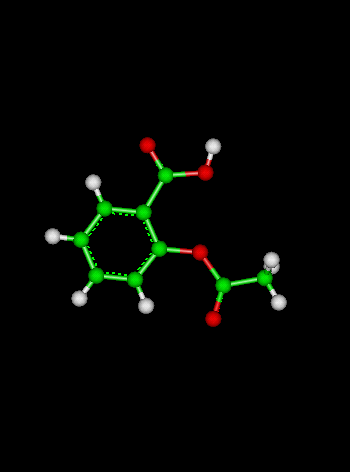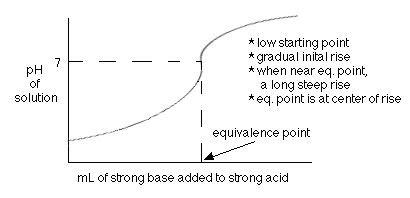
Course Chapters
Section Tests
Online Calculators Linear Least Squares Regression Newton's Method Equation Solver
Related Information Links
|
Acid-Base ChemistryWaterWe typically talk about acid-base reactions in aqueous-phase environments -- that is, in the presence of water. The most fundamental acid-base reaction is the dissociation of water:
In this reaction, water breaks apart to form a hydrogen ion (H+) and a hydroxide ion (OH-). In pure water, we can define a special equilibrium constant (Kw) as follows:
Where Kw is the equilibrium constant for water at 25° C (unitless) An equilibrium constant less than one (1) suggests that the reaction prefers to stay on the side of the reactants -- in this case, water likes to stay as water. Because water hardly ionizes, it is a very poor conductor of electricity.
At equilibrium, the concentration of H+ is 1.00 × 10-7, so we can calculate the pH of water at equilibrium as:
Solutions with a pH of seven (7) are said to be neutral, while those with pH values below seven (7) are defined as acidic and those above pH of seven (7) as being basic. pOH gives us another way to measure the acidity of a solution. It is just the opposite of pH. A high pOH means the solution is acidic while a low pOH means the solution is basic.
pH + pOH = 14.00 at 25°C
SaltsA salt is formed when an acid and a base are mixed and the acid releases H+ ions while the base releases OH- ions. This process is called hydrolysis. The pH of the salt depends on the strengths of the original acids and bases:
These salts are acidic or basic due to their acidic or basic ions. When weak acids or weak bases react with water, they make strong conjugate bases or conjugate acids, respectively, which determines the pH of the salt. Acid-Base CharacterFor a molecule with a H-X bond to be an acid, the hydrogen must have a positive oxidation number so it can ionize to form a positive +1 ion. For instance, in sodium hydride (NaH) the hydrogen has a -1 charge so it is not an acid but it is actually a base. Molecules like CH4 with nonpolar bonds also cannot be acids because the H does not ionize. Molecules with strong bonds (large electronegativity differences), are less likely to be strong acids because they do not ionize very well. For a molecule with an X-O-H bond (also called an oxoacid) to be an acid, the hydrogen must again ionize to form H+. To be a base, the O-H must break off to form the hydroxide ion (OH-). Both of these happen when dealing with oxoacids.Strong Acids: These acids completely ionize in solution so they are always represented in chemical equations in their ionized form. There are only seven (7) strong acids:
To calculate a pH value, it is easiest to follow the standard "Start, Change, Equilibrium" process.
Example Problem: Determine the pH of a 0.25 M solution of HBr.
Weak Acids: These are the most common type of acids. They follow the equation:
The equilibrium constant for the dissociation of an acid is known as Ka. The larger the value of Ka, the stronger the acid.
Example Problem: Determine the pH of 0.30 M acetic acid (HC2H3O2) with the Ka of 1.8x10-5.
Strong Bases: Like strong acids, these bases completely ionize in solution and are always represented in their ionized form in chemical equations. There are only eight (8) strong bases:
Example Problem: Determine the pH of a 0.010 M solution of Ba(OH)2.
Weak Bases: These follow the equation:
example: NH3 + H2O Kb is the base-dissociation constant:
Ka x Kb = Kw = 1.00x10-14 To calculate the pH of a weak base, we must follow a very similar "Start, Change, Equilibrium" process as we did with the weak acid, however we must add a few steps.
Example Problem: Determine the pH of 0.15 M ammonia (NH3) with a Kb=1.8x10-5.
When dealing with weak acids and weak bases, you also might have to deal with the "common ion effect". This is when you add a salt to a weak acid or base that contains one of the ions present in the acid or base. To be able to use the same process to solve for pH when this occurs, all you need to change are your "start" numbers. Add the molarity of the ion, which comes from the salt, and then solve the Ka or Kb equation as you did earlier.
Example Problem: Find the pH of a solution formed by dissolving 0.100 mol
of HC2H3O2 with a Ka of
1.8x10-8 and 0.200 mol of NaC2H3O2 in a total volume of 1.00 L.
 For the titration of a strong base with a weak acid, the equivalence point is reached when the pH is greater than seven (7). The half equivalence point is when half of the total amount of base needed to neutralize the acid has been added. It is at this point where the pH = pKa of the weak acid.  In an acid-base titration, the base will react with the weak acid and form a solution that contains the weak acid and its conjugate base until the acid is completely gone. To solve these types of problems, we will use the Ka value of the weak acid and the molarities in a similar way as we have before. Before demonstrating this way, let us first examine a short cut, called the Henderson-Hasselbalch Equation. This can only be used when you have some acid and some conjugate base in your solution. If you only have acid, then you must do a pure Ka problem and if you only have base (like when the titration is complete) then you must do a Kb problem.
Where: Example Problem: 25.0 mL of 0.400 M KOH is added to 100. mL of 0.150 M benzoic acid, HC7H5O2 (Ka=6.3x10-5). Determine the pH of the solution.
Practice weak acid problem: C6H5COONa is a salt of a weak acid C6H5COOH. A 0.10 M solution of C6H5COONa has a pH of 8.60.
See the weak acid solution. Practice titration problem: 20.00 mL of 0.160 M HC2H3O2 (Ka=1.8x10-5) is titrated with 0.200 M NaOH.
See the titration solution.
[Basic Index]
[Chemical Nomenclature]
[Atomic Structure]
[Periodic Table] | ||||||||||||||||||||||||||||||||||||||||||||||||||||||||||||||||||||||||||||||||||||||||||||||||||||||||||||||||||||||||||||||||||||||||||||||||||||||||||||||||||||||||||||||||||||||||||||||||||||||||||||||||||||||||||||||||||||||||||||||||||||||||||||||||||||||||||||||||||||||||||||||||||||||||||||||||||||||||||||||||||||||||||||||||||||||||||||||||||||||||||||||||||||||||||||||||||||||||||||||||||||||||||||||||||||||||||||||||||||||||||||||||||||||||||||||||||||||||||||||||||||||||||||||||||||||||||
 Shodor
Shodorin cooperation with the Department of Chemistry,
The University of North Carolina at Chapel Hill
Copyright © 1996-2008 Shodor
Last Update: Sunday, 06-Oct-2002 13:08:39 EDT
Please direct questions and comments about this page to
[email protected]